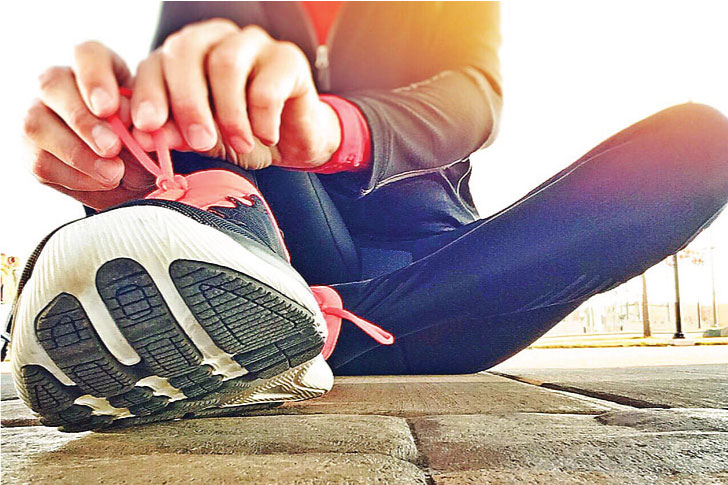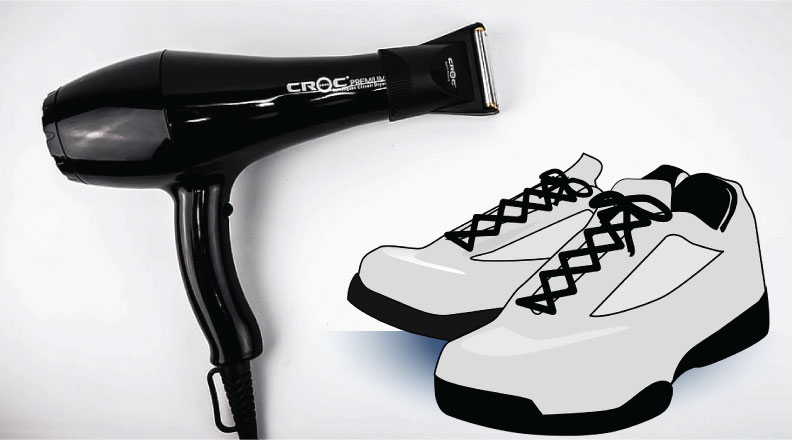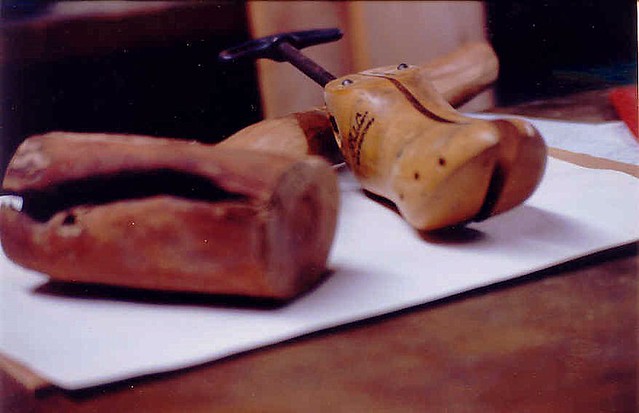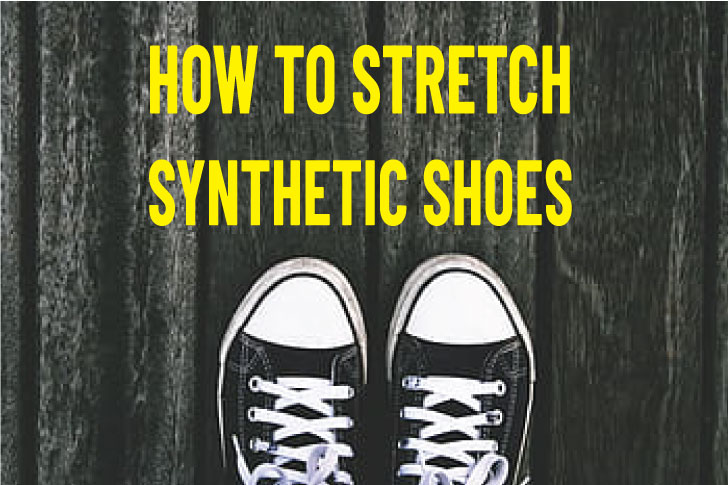We’re gonna show you the Best Ways To Stretch Your Synthetic Shoes!

Everyone enjoys a pair of new shoes but breaking into them is a task that is hard to deal with. From the bunions to the blisters – the pain of stretching your synthetic shoes can be overwhelming.
Though every kind of shoe requires some form of getting used to, it’s the synthetic shoes that make this problem way worse. The lack of flexibility or breathability continues to be the major problem for synthetic shoes.
Today we will discuss the ways of synthetic shoe stretching. Then you will know how to stretch synthetic shoes.
Contents
Understanding Your Synthetic Shoes
Have you ever been drawn to the vibrant and imaginative colors and designs of synthetic shoes? Synthetic shoes are made of man-made materials and offer a great alternative to leather shoes. As a shoe lover, you need to understand your synthetic shoes to maintain their life span and ensure their fitness.
Let’s take a closer look at synthetic shoes, their advantages and disadvantages, and types based on material and design.
What Are Synthetic Shoes?
Synthetic shoes use a wide range of materials other than traditional leather, including rubber, pvc, microfiber, and nylon. This mix of materials gives synthetic shoes a modern and sustainable look. They are extremely versatile and easy to clean and maintain.
Additionally, synthetic shoes don’t require a break-in period, unlike leather shoes, and can be worn for hours without causing any irritation or discomfort.
Benefits And Drawbacks Of Synthetic Shoes
Synthetic shoes have several benefits such as:
- They are affordable, making them perfect for people on a budget.
- They are highly resistant to stains and water damage.
- They are easy to clean and dry quickly.
- They are animal-friendly.
- They come in various designs and colors, allowing one to express their style.
- They don’t require any break-in period and offer an immediate comfortable experience.
On the other hand, the advantages of synthetic shoes come with certain drawbacks, such as:
- They might lack the durability and breathability of real leather.
- They can be less comfortable and offer inferior support compared to leather shoes.
- They often emit an unpleasant odor after a while.
- They may be less formal and elegant than leather shoes.
Types Of Synthetic Shoes Based On Material And Design
There are various types of synthetic shoes based on material and design, including:
- Synthetic leather: Made from a mixture of plastic and synthetic materials. Synthetic leather is water-resistant, lightweight, and easy to clean.
- Synthetic mesh: Created from synthetic fabric and featuring air pockets for improved breathability. Synthetic mesh shoes are perfect for high-intensity workouts, as they provide increased support and ventilation.
- Synthetic suede: Made from synthetic fibers woven together to form a texture that is similar to natural suede. Synthetic suede is more affordable and easier to clean than real suede.
- Vegan shoes: Vegan shoes are entirely free from animal-derived materials. They are made from a combination of synthetic materials such as microfibers, organic cotton, and recycled plastics.
Now that we have a better understanding of synthetic shoes, we can make more informed decisions regarding their care and maintenance. With the right care and attention, synthetic shoes can last a long time and remain stylish and comfortable for years to come.
Signs Your Shoes Are Too Tight
Stretching synthetic shoes can be a bit of a challenge, especially when they feel tight from the get-go- it’s as though your feet are being squished! If you have been struggling to get them on or have noticed some discomfort, pinching and rubbing, then chances are that your shoes are too tight.
Worry not, we’ve got you covered with 6 easy ways to stretch your synthetic shoes and make them comfortable. Before we dive into the stretching techniques, let’s take a close look at some of the signs indicating that your shoes are too tight.
Feeling Of Discomfort And Pain
When wearing synthetic shoes that are too tight, you will feel an unpleasant sensation, such as a tight grip around your feet. Often, this high amount of pressure can lead to pain and discomfort while walking. This is a clear indication that your shoes are too tight and need to be stretched.
Pinching Or Rubbing Of Toes And Foot
If your synthetic shoes are pinching or rubbing against your toes and feet, it’s another sign that the shoes are too tight and require breaking in. This pinching sensation can cause extreme discomfort and can even lead to blisters, corns, and calluses.
- To determine if there is enough space for your foot in the shoe, wiggle your toes. If your toes don’t have enough space, your shoes are too tight and need stretching.
- Check for any redness or sore spots on your feet. This is usually an indication of tight shoes.
Development Of Blisters, Corns And Calluses
If you’ve noticed small, hard, and raised areas of skin on your feet, or blisters in places where your shoes tend to rub, then your shoes may be too tight. Blisters, corns, and calluses form when your skin is repeatedly rubbed against a particular surface.
When the shoes are too tight, your feet are subject to friction and rubbing, causing these skin irritations.
- Blisters commonly occur at the back of heel and the toes.
- Corns and calluses usually appear on the ball of your foot and toes.
Stretching your synthetic shoes can easily solve these problems by increasing the width and length of the shoe, reducing pressure on your feet. Use the 6 easy ways we have provided to stretch your synthetic shoes and make them comfortable to wear.
How To Stretch Synthetic Shoes – Diy Hacks
Stretching synthetic shoes can be a challenging task, but there are several easy diy hacks that can make the process much simpler. Whether you have purchased a new pair of synthetic shoes that need stretching or you need to make an old pair more comfortable, these six hacks can get the job done.
Here are six easy ways to stretch synthetic shoes.
1. Start Walking
The best way to break into your new pair of synthetic shoes is by walking in them. Put on a pair of thick socks and wear your shoes. The thickness of the socks will determine how much you wish to stretch your synthetic shoes. You will have to bend and flex your shoes while you’re at it.
2. A Hairdryer Will Get The Job Done
A hairdryer is a good option to stretch synthetic shoes. This is a tried and tested method that is guaranteed to offer outstanding results. In order to do so, you’ll require a pair of socks and a hairdryer (of course!). Follow these steps and you’ll see how wonderfully your shoes have stretched.

- Put on a pair of thick socks. Don’t have thick socks? How about putting on several pairs at the same time?
- Once you have your pair of socks and shoes on, set your hair dryer to medium temperature.
- Point your hairdryer in the affected area of your shoes or the front. You have to do this for only 30 seconds. Wriggle your toes inside to expand the material.
Once you have used a hairdryer to expand your shoes, you must walk around in your shoes. If you feel your synthetic shoes haven’t expanded as much as you would like to repeat the procedure.
3. Stuff It
Another way to ensure your synthetic shoes have stretched in size is by stuffing it. This easy trick will expand your shoes and offer your feet the room it needs to feel comfortable. To stretch your synthetic shoes you will need,
- A jug of water and
- Newspaper

- Crumble up a few newspapers to stuff the area of your synthetic shoes that you wish to stretch.
- Once you have made the paper balls, moisten them slightly. This will reduce their size. You must keep in mind that you don’t need to soak the newspaper balls in the water. It can cause your shoes to suffer.
- Place the moistened newspaper balls inside your shoes and allow them to dry naturally. Keep it inside your shoes for a minimum of 5 hours or overnight.
- Keep in mind to stuff your shoes evenly. This will prevent it from losing its natural shape.
4. The Use Of Alcohol

One of the most popular ways of stretching shoes is by using alcohol. Mix alcohol with a small amount of water. Spray this evenly on the interiors and exteriors of your shoes. You must make sure that your shoes don’t get soaking wet.
You can create paper balls and stuff them inside your shoes before you spray them with alcohol. Remember the paper you use should be free from ink. Otherwise, it will end up ruining your shoes. Allow your shoes to dry naturally.
Read also: How To Condition Leather Boots?
5. Will Freezing Work?
Another remarkable trick to stretch your synthetic shoes is by carefully placing a securely tied plastic bag filled with water inside the shoes. Now place the shoes inside your freezer. As the water starts to freeze, it will expand which in turn will stretch shoes. You can even stuff the front of the shoes with a rolled-up newspaper and then place the water-filled plastic bag inside it.
So, one effective way of stretching synthetic shoes at home is by freezing them. This method works wonders for breaking in a new pair of shoes that are too tight. Here’s how you can accomplish this hack:
- Fill a sandwich bag with water and seal it tightly.
- Place the bag inside the shoe.
- Put the shoes in the freezer for a few hours, or until the water in the bag turns into ice.
- Leave the shoes out at room temperature until the ice melts to room temperature, and then remove the bag and put on the shoes.

6. Shoe Stretchers Are Bound To Get The Job Done
If you’re willing to spend a little money, this is the choice you make. Purchase a good-quality shoe stretcher that will expand the interiors of your shoes with its leadscrew. It works better with a spray.

Here’s how you can accomplish this:
- Purchase a shoe stretcher that fits the size and shape of your shoes.
- Insert the shoe stretcher inside your synthetic shoes, ensuring a comfortable fit.
- Leave the shoe stretcher in for a minimum of 24 hours before removing it.
These are a few of the best ways for stretching synthetic shoes. By following any of these six easy hacks, you can quickly and effectively transform a pair of tight, uncomfortable shoes into a comfortable and wearable pair.
Professional Options For Stretching Shoes
Stretching your synthetic shoes can be a challenging task, especially when you want to avoid damaging the material. While there are various diy techniques to try, sometimes it’s best to leave it to the professionals. In this section, we will evaluate professional shoe stretches.
Evaluation Of Professional Shoe Stretches
When it comes to stretching synthetic shoes, professional shoe stretching services are the safest and most effective option. Here are some key points to consider:
- Professional shoe stretching services can be expensive, with costs ranging from $20 to $100, depending on the store.
- Some professional services use stretching sprays, while others use stretching machines. It’s essential to inquire about the technique before choosing a store.
- Professional stretches are suitable for all types of synthetic shoes, including boots, flats, and high heels.
- The stretching process takes around 24 to 48 hours, and the results can last for a long time.
- Professional services offer guarantees, ensuring that the stretched shoes fit comfortably.
Comparison Of Stretching Services Offered By Different Stores
If you decide to go for professional shoe stretching, it’s crucial to choose a reliable store that guarantees efficient services. Here are some aspects to consider when comparing stretching services offered by different stores:
- Check the reviews and ratings of previous customers to gauge the quality of services.
- Inquire about the charges to avoid unpleasant surprises during payment.
- Check if the store offers guarantees or refunds if the shoes don’t fit as expected.
What To Look For In A Professional Shoe Stretcher
The success of your shoe stretching process depends on the person handling your shoes. Therefore, it’s essential to choose a store with trained and experienced shoe stretchers. Here are crucial aspects to consider:
- Check if the store has certified and experienced shoe stretchers.
- Inquire about the technique used to stretch the shoes. A stretching machine is preferable to avoid any damage to the material.
- Check if the store has the required equipment to handle different types of materials, such as leather, suede, or vinyl.
- Inquire about the time taken to complete the stretching process, and check if it fits your schedule.
Professional shoe stretching services are a reliable and effective technique of stretching your synthetic shoes. Carefully evaluate different stores to choose a reliable and experienced shoe stretcher. With the right store, you can enjoy comfortable and well-fitting shoes.
Frequently Asked Questions
How Do I Stretch My Synthetic Shoes At Home?
You can stretch synthetic shoes at home using popular methods such as using a hairdryer, socks, freezing them, and using a shoe stretcher. With the right techniques and tools, you can achieve a comfortable fit without damaging your shoes.
Will Stretching Synthetic Shoes Affect Their Quality?
Stretching synthetic shoes often damages the material, but you can minimize this by using appropriate techniques. In some cases, the quality may diminish, but stretching the shoes can help extend their life by making them more comfortable to wear.
Can I Stretch All Types Of Synthetic Shoes?
You can stretch most types of synthetic shoes, including faux leather, rubber, and neoprene, but the methods might differ depending on the material and type of shoes. Always refer to the manufacturer’s instructions before stretching your shoes.
Conclusion
Now you know the easy and effective ways to stretch synthetic shoes. Don’t let tight shoes ruin your day or night out. Remember, patience and persistence is key in this process. It’s important to take your time and not rush it, ensuring that the shoe is gradually stretched and fits comfortably.
If one method doesn’t work, don’t give up, try another one and see what works best for you. With these 6 simple methods, you can easily stretch your synthetic shoes at home without spending extra money on a professional. Stretching your shoes not only saves you money but also makes them comfortable to wear.
Enjoy your newly stretched synthetic shoes and take on the day with confidence.
Read also: How to condition leather boots
Read also: How to get paint off leather boots


14 thoughts on “How To Stretch Synthetic Shoes? (6 Easy Ways)”